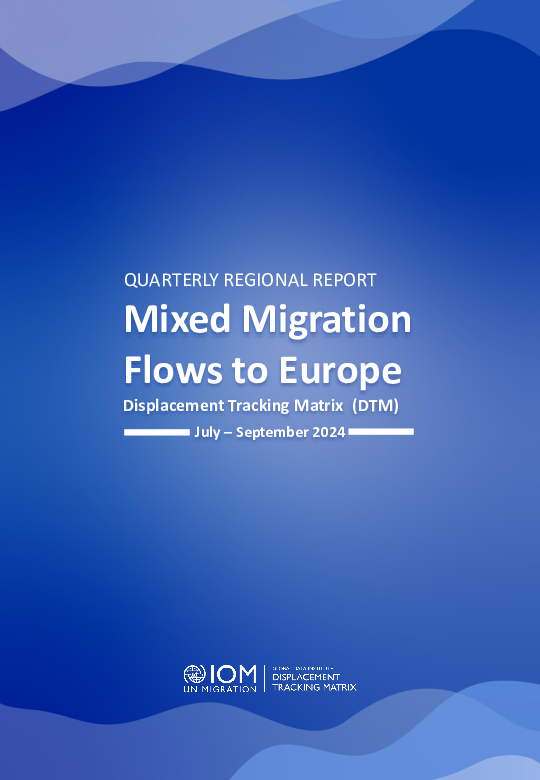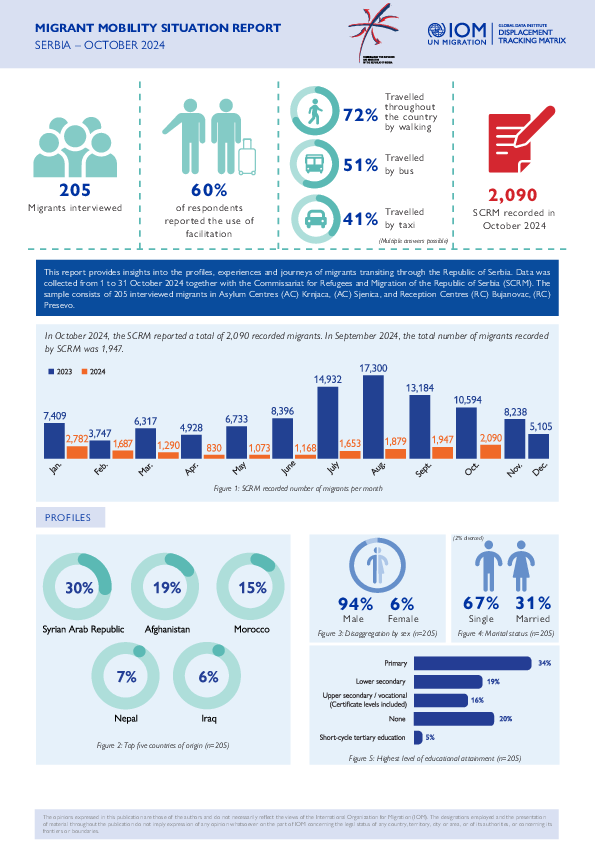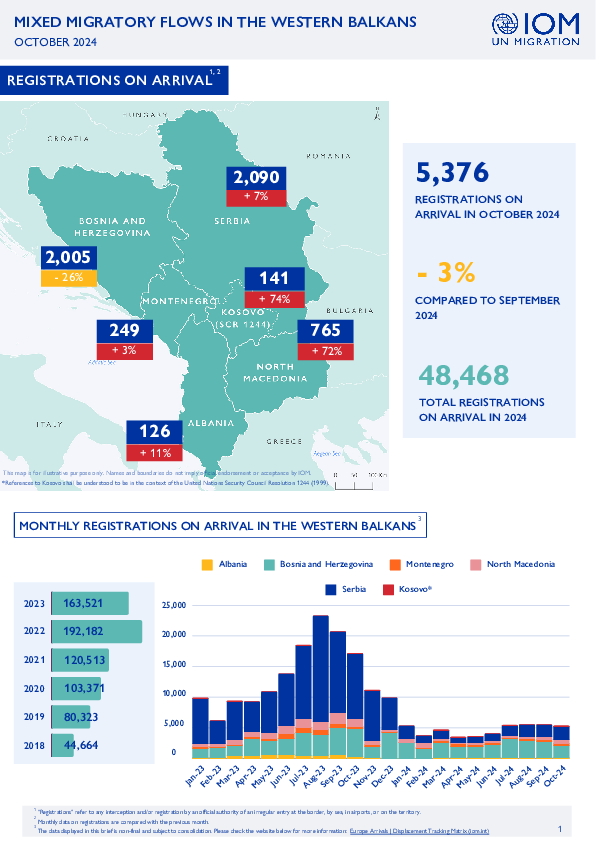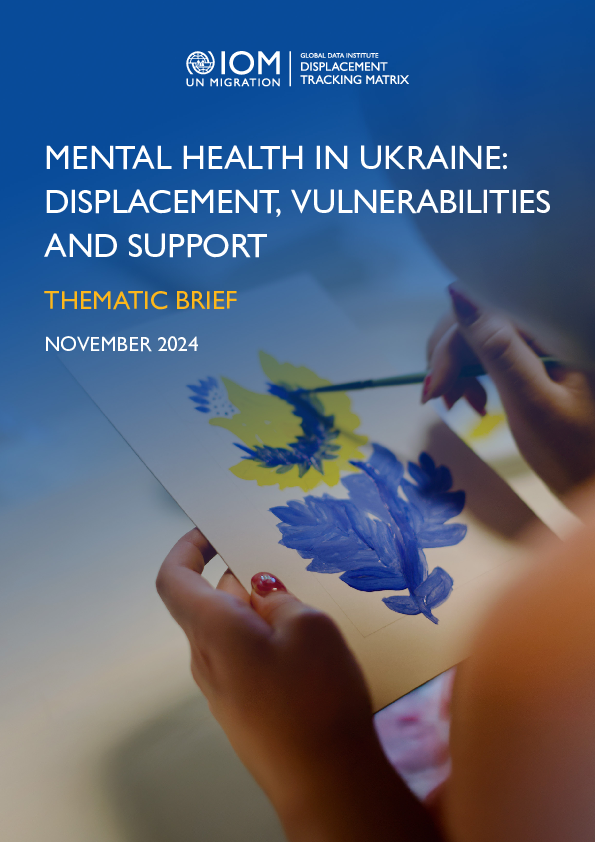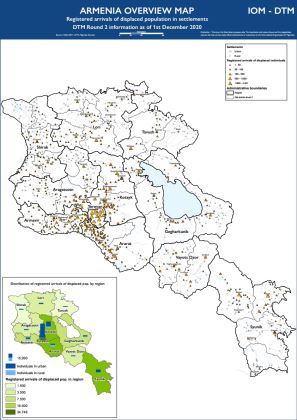-
Countries
-
Data and Analysis
-
Special Focus
-
Crisis Responses
Europe and Central Asia
DTM Europe and Central Asia
DTM Operations in the region
- Active DTM operation
- Past DTM operation
Europe — Mixed Migration Flows to Europe, Quarterly Overview (July-September 2024)
DTM Europe gathers, validates and disseminates information on migrants and refugees travelling through the Mediterranean, Western African Atlantic, and Western Balkan routes to Europe. Key routes include:
Ukraine — Income, Social Protection and Coping Strategies in Ukraine — November 2024
Since the full-scale invasion of Ukraine in February 2022, the country has confronted profound economic disruptions alongside widespread displacement.
Bosnia & Herzegovina — Situacioni Izvještaj o Mobilnosti Migranata (Oktobar 2024)
Ovaj izvještaj pruža uvid u profile, iskustva, potrebe, puteve i namjere migranata koji prolaze kroz Bosnu i Hercegovinu (BiH).1 Podaci su prikupljani od 1. do 31. oktobra 2024.
Nov 15 2024
Bosnia & Herzegovina — Situacioni Izvještaj o…
Türkiye — Migrant Presence Monitoring - Situation Report (October 2024)
According to the latest figures from the Turkish Presidency of Migration Management (PMM), there are more than 4.3 million foreigners in Türkiye, of whom 3.3 million are seeking international protection.
Ukraine — Employment, Mobility and Labour Market Dynamics in Ukraine — November 2024
As of 15 October 2024, 3.7 million people remain internally displaced (IDPs), while 4.4 million people who had been displaced have since returned to their primary places of residence.
Bosnia & Herzegovina — Migrant Mobility Situation Report (October 2024)
This report provides insights into the profiles, experiences, needs, routes travelled and intentions of migrants transiting through Bosnia and Herzegovina (BiH).1 Data was collected from 1 to 31 October 2024.
Nov 15 2024
Bosnia & Herzegovina — Migrant Mobility Situat…
Western Balkans — Migrant Mobility Situation Report (October 2024)
This report provides insights into the profiles, experiences, needs, routes travelled and intentions of migrants transiting through the Western Balkans.
Western Balkans — Мешани Миграциски Текови (Октомври 2024)
Monthly overview of: Arrivals in the Western Balkans Top three nationalities at arrivals in the reporting month Migrants presence in reception facilities Assisted Voluntary Returns and reintegration
North Macedonia — Квартални извештај (Јули-Септември 2024)
Овој извештај, заснован на пристап со повеќе методи и повеќе извори, дава увид во профилите, искуствата, потребите, рутите и намерите на мигрантите кои транзитираат низ Република Северна Македонија.
Україна — ПРОФІЛІ ОБЛАСТЕЙ — Опитування загального населення Раунд 17 (серпень 2024)
Профілі областей ґрунтуються на даних раунду 17 Опитування загального населення МОМ в Україні, з акцентом на демографічних показниках і переміщенні населення, прийнятті стратегій виживання для задоволення потреб, зайнятості та доходах, грошовій допомозі на проживання ВПО та житлових питаннях.
Western Balkans — Mješoviti Migracijski Tokovi (Oktobar 2024)
Monthly overview of: Arrivals in the Western Balkans Top three nationalities at arrivals in the reporting month Migrants presence in reception facilities Assisted Voluntary Returns and reintegration
Serbia — Migrant Mobility Situation Report (October 2024)
This report provides insights into the profiles, experiences and journeys of migrants transiting through the Republic of Serbia. Data was collected from 1 to 31 October 2024 together with the Commissariat for Refugees and Migration of the Republic of Serbia (SCRM).
Western Balkans — Flukset e Përziera Migratore (Tetor 2024)
Monthly overview of: Arrivals in the Western Balkans Top three nationalities at arrivals in the reporting month Migrants presence in reception facilities Assisted Voluntary Returns and reintegration
Оценка базовой мобильности в Казахстане (Раунд 4)
МTM реализует Оценку базовой мобильности (BMA) в Казахстане для отслеживания мобильности, предоставления информации о численности населения, географическом распределении мждународных трудящихся мигрантов, вернувшихся мигрантов и эмигрантов, причин миграции, а также стран происхождения, возвращени
ВРАЗЛИВІСТЬ ДО ТОРГІВЛІ ЛЮДЬМИ ТА ТРУДОВОЇ ЕКСПЛУАТАЦІЇ В УКРАЇНІ (червень 2024)
Повномасштабне вторгнення Російської Федерації в Україну в лютому 2022 року спричинило масове переміщення та гуманітарну кризу, що підвищило вразливість населення до ризиків у сфері захисту, зокрема торгівлі людьми, особливо серед переміщених та постраждалих від конфлікту громад.
Western Balkans — Mixed Migratory Flows Report (October 2024)
Monthly overview of: Arrivals in the Western Balkans Top three nationalities at arrivals in the reporting month Migrants presence in reception facilities Assisted Voluntary Returns and reintegration
Польща — Короткий Звіт: Зміни у сфері працевлаштування, житла та соціальної інтеграції біженців з України в Польщі
У березні 2023 року МОМ Польща розпочала інтеграційне опитування, щоб оцінити прогрес і потреби, пов'язані з економічною та соціальною інтеграцією біженців з України в Польщі.
Serbia — Situacioni Izveštaj o Mobilnosti Migranata (Oktobar 2024)
Ovaj izveštaj pruža uvid u profile, iskustva i putovanja migranata koji prolaze kroz Republiku Srbiju. Podaci su prikupljani od 1. do 31. oktobra 2024. godine u saradnji sa Komesarijatom za izbeglice i migracije Republike Srbije (KIRS).
North Macedonia — Quarterly Report Q3 (July-September 2024)
This report, based on a multi-method and multi-source approach, provides insights into the profiles, experiences, needs, routes and intentions of migrants transiting through North Macedonia.
Казахстан – опрос международных трудящихся-мигрантов в Казахстане (раунд 4)
MTM проводит опрос международных трудящихся-мигрантов в Казахстане в семи регионах и трех городах Казахстана. Выборка локаций проведения опросов был основан на результатах Базовой оценки мобильности (BMA) МОМ по международным трудящимся-мигрантам.
Uzbekistan - Migration Data Gaps Analysis — (January 2024)
This report summarizes findings from the Migration Data Mapping Exercise in Uzbekistan, which identifies and evaluates existing migration data sources within national government databases, UN agencies, and development organizations.
O'zbekiston - Migratsiya ma’lumotlaridagi bo‘shliqlarni tahlil qilish (2024-yil yanvar)
Ushbu hisobot O‘zbekistonda o‘tkazilgan Migratsiya ma’lumotlaridagi bo‘shliqlarni tahlil qilish tadqiqotidan olingan natijalarni umumlashtirib, tegishli milliy ma’lumot bazalari, BMT agentliklari va rivojlanish tashkilotlaridagi mavjud migratsiya ma’lumotlari manbalarini aniqlash va baholashni o‘
Nov 11 2024
O'zbekiston - Migratsiya ma’lumotlaridagi bo…
Ukraine —Mental Health in Ukraine: Displacement, Vulnerabilities and Support — November 2024
As of October 2024, an estimated 3.6 million people remain internally displaced in Ukraine, while 4.3 million previously displaced people have returned to their primary place of residence (IOM GPS R18).
Pagination
Europe — Mixed Migration Flows to Europe, Quarterly Overview (July-September 2024)
Nov 28 2024
<p>The file contains the following sheets</p><figure class="table"><table><tbody><tr><td><strong>Sheet</strong></td><td><strong>Content</strong></td><td><strong>Countries and Areas</strong…
Ukraine — Area Baseline Assessment — Round 37
Nov 12 2024
<ul><li><strong>Kharkivska (388,410), Dnipropetrovska (377,713), and Kyivska (256,397) Oblasts</strong> have the highest numbers of officially registered IDPs.&nbsp;</li><li>Across the country, around <strong>5&nbsp;per cent of registered IDPs have…
Ukraine — Area Baseline Assessment — Round 38
Nov 12 2024
<ul><li><strong>Kharkivska (390,872), Dnipropetrovska (379,133), and Kyivska (257,606)&nbsp;Oblasts</strong> have the highest numbers of officially registered IDPs.</li><li>Across the country, around <strong>10&nbsp;per cent of registered IDPs have…
Tajikistan – Baseline Mobility Assessment - Round 4 (May 2024)
Sep 11 2024
<p>This assessment covered <strong>948</strong> communities through focus group discussions with 3,288 key informants. Based on the key informants' estimates, <strong>1,060</strong> international migrant workers were hosted in the assessed communities in…
Europe — Mixed Migration Flows to Europe, Quarterly Overview (April-June 2024)
Sep 09 2024
<p>The file contains the following sheets</p><figure class="table"><table><tbody><tr><td><strong>Sheet</strong></td><td><strong>Content</strong></td><td><strong>Countries and Areas</strong…
Kazakhstan – Baseline Mobility Assessment - Round 3 (Jan 2024)
Sep 06 2024
<p>During the assessment, 2,303 key informants were interviewed. Based on the key informants' estimates, <strong>639,799</strong> international migrant workers were hosted in the assessed locations in Kazakhstan from 2020 to 2023. Concurrently, <strong>41,574</strong…
Tajikistan – Baseline Mobility Assessment - Round 3 (Apr 2024)
Jul 12 2024
<p>The Baseline Mobility Assessment (BMA) was conducted in all five provinces and all 12 districts/cities of Tajikistan (including Ismoili Somoni, Sino, Firdawsi, Shohmansur districts of Dushanbe city, Vahdat city, Rudaki district of Districts of Central Subordination, Khujand city of Sughd…
Ukraine — Area Baseline Assessment — Round 36
Jul 11 2024
<p><strong>Kharkivska (388,118), Dnipropetrovska (373,301), and Kyivska (259,568) Oblasts</strong> have the highest numbers of officially registered IDPs.&nbsp;</p>
Ukraine — Area Baseline Assessment — Round 35
Jul 11 2024
<p><strong>Kharkivska (384,897), Dnipropetrovska (377,837), and Kyivska (300,080) Oblasts</strong> have the highest numbers of officially registered IDPs.&nbsp;</p>
Europe — Mixed Migration Flows to Europe, Quarterly Overview (January-March 2024)
Jun 27 2024
<p>The file contains the following sheets</p><figure class="table"><table><tbody><tr><td><strong>Sheet</strong></td><td><strong>Content</strong></td><td><strong>Countries and Areas</strong…
Ukraine — Conditions of Return Assessment Dataset — Round 7 (Feb-Mar 2024)
May 10 2024
<p>The Conditions of Return Assessment is a tool designed to measure the population and severity of conditions in locations of return. The assessment is based on 20 indicators divided into 5 ‘drivers’: (1) livelihoods, (2) utilities and services (3) residential destruction, (4) Safety and…
Ukraine — Mobility and Needs Assessment — Round 7 (March 2024)
Apr 29 2024
<p>IOM's Data and Analytics (D&amp;A) Unit developed the Mobility and Needs Assessment (MaNA), a monthly, multi-sectoral assessment designed to systematically monitor the estimated current presence of key population groups, including de facto Internally Displaced Persons (IDPs),…
Ukraine — Area Baseline Assessment — Round 34
Apr 17 2024
<p>The data collected for the Area Baseline Assessment Round 34 reflects the&nbsp;up-to-date local administrative register of the IDP population as of 31 March 2024, equivalent to a total of <strong>3,387,291 </strong>registered IDPs. Registered IDP figures were collected for…
Kyrgyzstan — Returning Migrant Worker Survey — Round 2
Apr 08 2024
<p>The dataset presents findings from surveys conducted in Kyrgyzstan using the International Organization for Migration's (IOM) Mobility Tracking Matrix (MTM) system. Adapted from IOM's Global Displacement Tracking Matrix (DTM) methodology, MTM aims to collect and analyze data to…
Kyrgyzstan — Baseline Assessment — Round 2
Apr 08 2024
<p>The dataset presents findings from key informant interviews conducted in Kyrgyzstan using the International Organization for Migration's (IOM) Mobility Tracking Matrix (MTM) system. Adapted from IOM's Global Displacement Tracking Matrix (DTM) methodology, MTM aims to collect and…
Ukraine — Mobility and Needs Assessment — Round 6 (February 2024)
Apr 08 2024
<p>IOM's Data and Analytics (D&amp;A) Unit developed the Mobility and Needs Assessment (MaNA), a monthly, multi-sectoral assessment designed to systematically monitor the estimated current presence of key population groups, including de facto Internally Displaced Persons (IDPs),…
Tajikistan – Return Migrant Worker Survey - Round 2
Apr 02 2024
<p>The surveys were conducted with return migrant workers using IOM’s Mobility Tracking Matrix (MTM) system in Tajikistan. The survey locations were selected based on the results of IOM’s Baseline Mobility Assessment on returning migrant workers. The report includes findings on socio-economic…
Ukraine — Mobility and Needs Assessment — Round 1 (Jul-Aug 2023)
Mar 21 2024
<p>During this round of data collection, IOM Ukraine's Data &amp; Analytics Unit conducted assessments in 85 hromadas across 50 raions and 20 oblasts. &nbsp;Assessed hromadas were selected based on their relevance to humanitarian and recovery programming, pre-war population size…
Ukraine — Conditions of Return Assessment Dataset — Round 6 (Nov-Dec 2023)
Mar 21 2024
<p>The Conditions of Return Assessment is a tool designed to measure the population and severity of conditions in locations of return. The assessment is based on 20 indicators divided into 5 ‘drivers’: (1) livelihoods, (2) utilities and services (3) residential destruction, (4) Safety and…
Ukraine — Area Baseline Assessment — Round 33
Mar 19 2024
<p>The data collected for the Area Baseline Assessment Round 33 reflects the&nbsp;up-to-date local administrative register of the IDP population as of 29 February 2024, equivalent to a total of <strong>3,413,472 </strong>registered IDPs. Registered IDP figures were collected…
Pagination
Arrivals Of Displaced Individuals In Settlements Overview - Round 3
This map is representing an overview of arrivals of displaced indivials in settlements of Round 3. Round 3 data was received on 9 December 2020 as export of anonymized individual records from registration database with information on age, sex, shelter, region of origin in NK and current settlement location in ARM. Processed by DTM team (on 9 and 10 December 2020) of IOM in Mobility Tracking, baseline database where population values were summarized for all 593 settlement after location and name verification. Aggregated number for tabulation by settlement and region were generated from DTM database. First release of data is published on DTM website on 11 December 2020 Detailed settlement dataset with geographic coordinates and settlement codes (from Armenia statistical office) connected to MS database settlement codes was generated. Geographic reference Armenia Admin 1, source HDX: https://data.humdata.org/dataset/armenia-administrative-boundaries Settlement, source https://ace.aua.am/vector-database-armenia-file-overview/
Arrivals of Displaced Individuals In Settlements Overview - Round 2
This map is representing an overview of arrivals of displaced indivials in settlements of Round 2.Round 1 data from Migration Service, Government of Armenia was received on 17 November 2020 and Round 2 data on 30 November as export from registration database as aggregates on settlement level with population values by settlement name in Armenian language in 11 regional worksheets. Data was processed by DTM team of IOM in Mobility Tracking baseline database where population values were entered each and one individually for all settlements after location and name verification. The map representing the arrivals in settlements is available through the following link: https://displacement.iom.int/maps/arrivals-displaced-individuals-settlements Aggregated number for tabulation by region are generated from DTM database. Detailed settlement dataset with geographic coordinates and settlement codes (from Armenia statistical office) was generated. Geographic reference:Armenia Admin 1,source HDX: https://data.humdata.org/dataset/armenia-administrative-boundaries Settlement, source: https://ace.aua.am/vector-database-armenia-file-overview/
Arrivals of displaced individuals in settlements
This map is representing an overview of arrivals of displaced indivials in settlements.On the morning of 27 September, renewed hostilities erupted in and around the Nagorno-Karabakh conflict zone. This was the latest flare up in a conflict that has been ongoing for over thirty years. On 9 November 2020, the Prime Minister of Armenia, the President of Azerbaijan, and the President of Russia announced a tripartite ceasefire agreement ending the hostilities in and around the Nagorno-Karabakh (NK) conflict zone.While data on the population displaced as a result of the conflict and their needs remains limited, a number of first efforts have been rolled out to assess displacement locations and needs. As the first efforts at collecting information on the needs of displaced and host communities are being rolled out in ten selected districts, an Information Management Working Group has been set up to coordinate efforts, led by the United Nations Resident Coordinator’s Office jointly with UNHCR and with the active participation of IOM. In meantime IOM has received the registration data form the Armenian Migration Service on 17 November 2020 as export from registration database as aggregates on settlement level with population values (of individuals and families) by settlement name. The latest registration data on spontaneous arrivals from the Armenian Migration Services from 17 November 2020 indicate that 81,408 spontaneous arrivals are scattered across 578 settlements and communities. 74 per cent of spontaneous arrivals are currently hosted in urban settlements, while 26 per cent are hosted in rural settlements. 39 per cent of the displaced have been registered in Yerevan, 19 per cent in Kotayk, and 9 per cent in Syunik.IOM will provide support with systematizing and presenting data that is already being collected by the UN agencies and other actors, drawing on its Displacement Tracking Matrix (DTM) tools and has deployed an expert to support this process.
